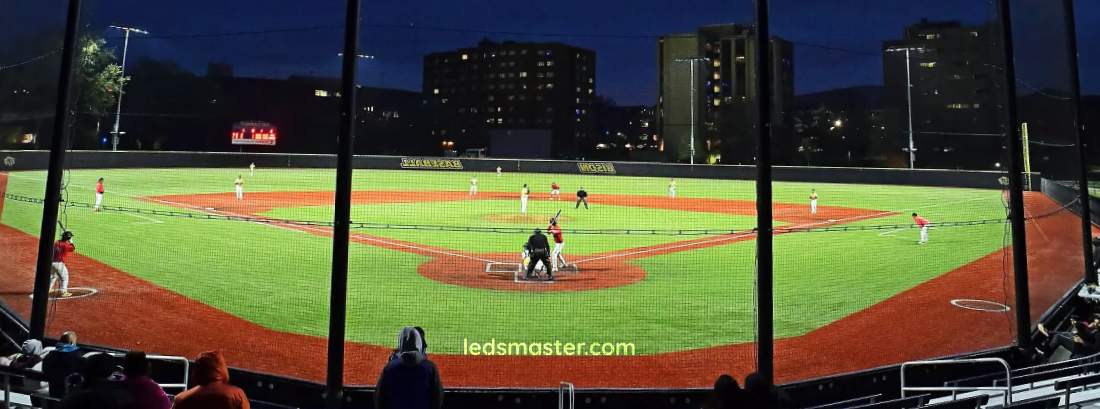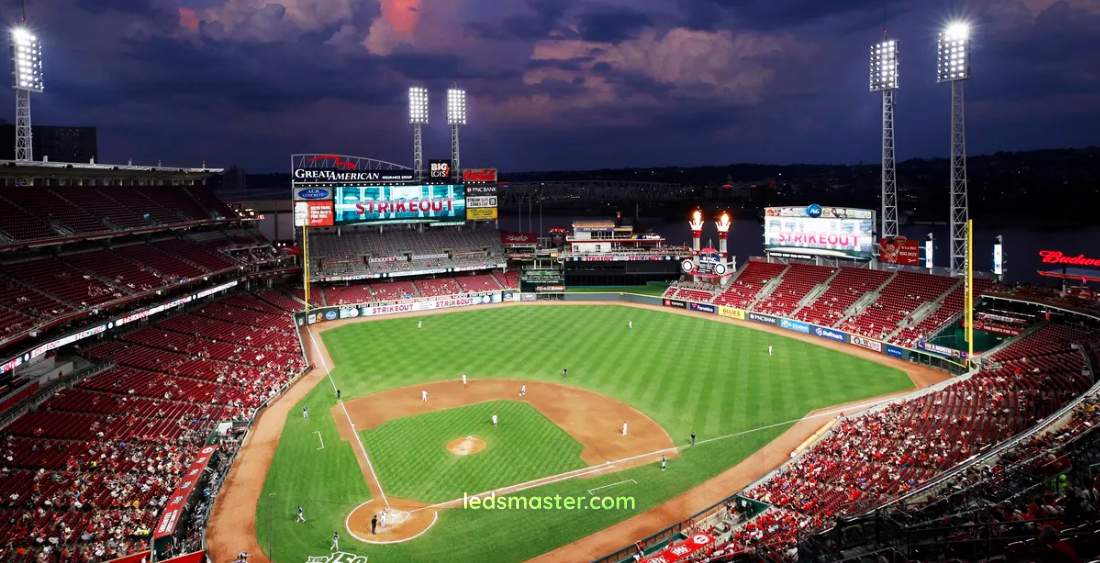Welcome to our comprehensive guide to softball field lighting! Whether you’re creating a new field or enhancing an existing setup, achieving optimal lighting is essential for improving gameplay, ensuring player safety, and enhancing the spectator experience. Explore how strategic lighting designs can elevate all facets of softball matches, from precise infield actions to clear outfield visibility, day or night.
Softball field lighting is pivotal for improving visibility and ensuring safe gameplay during evening matches. Beyond mere illumination, well-designed lighting systems enhance the field’s ambiance and elevate the spectator experience. This article delves into key aspects of softball field lighting, encompassing optimal design principles, advanced lighting technologies, and addressing frequently asked questions from prospective buyers.
Get your complimentary lighting design today
Table of Contents
ToggleAchieving uniform light distribution across a softball field is crucial for optimizing gameplay and ensuring fairness. Consistent illumination helps minimize shadows and dark spots, providing players with clear visibility of the entire playing surface. This uniformity not only enhances player performance but also reduces the risk of injuries caused by sudden changes in lighting intensity.
To achieve uniform light distribution, lighting fixtures must be strategically placed around the field. Designers often employ a combination of floodlights and directional fixtures positioned at optimal heights and angles. This careful placement ensures that every corner of the field receives adequate illumination, from the infield where precise movements are critical, to the outfield where players track long-distance balls.
Beyond uniformity, effective softball field lighting design includes measures to minimize glare. Glare occurs when excessive brightness or reflections hinder visibility, potentially affecting players’ ability to track the ball or judge distances accurately. Properly shielded fixtures and thoughtful placement help mitigate glare, ensuring clear visibility for both players and spectators throughout the game.

Uniform lighting directly contributes to enhanced player performance by providing consistent visual conditions. Players can react more quickly to the ball’s trajectory and make precise movements without being hindered by uneven light. This consistency fosters fair gameplay and supports athletes in showcasing their skills effectively under various playing conditions, from dusk to night matches.
In addition to improving gameplay, uniform lighting enhances safety on the softball field. By eliminating dark areas and ensuring visibility of potential hazards like uneven terrain or obstacles, uniform lighting reduces the risk of player collisions or injuries. This safety aspect is particularly crucial during fast-paced gameplay scenarios where split-second reactions can make a significant difference.
Infield areas of a softball field demand higher lux levels to facilitate the precision and quick reactions essential for players, particularly infielders. Lux, a measure of illuminance, directly affects visibility and the ability to react swiftly to the ball’s movements. Typically ranging from 200 to 300 lux, this level of illumination is meticulously calculated to ensure that infielders can perceive the ball with clarity, track its trajectory accurately, and make split-second decisions during plays.
The heightened lux levels in the infield are crucial for enabling players to execute defensive maneuvers such as catching, fielding ground balls, and swiftly transitioning between plays. Clear visibility not only enhances player performance but also contributes significantly to safety on the field, reducing the risk of errors or injuries due to obscured vision or misjudged distances. The precise lighting conditions in the infield are meticulously designed to support optimal gameplay conditions, ensuring that infielders can perform at their best under varying light conditions from day to night games.
Outfield areas of a softball field are designed with slightly lower lux requirements compared to the infield, typically ranging from 150 to 250 lux. This balanced approach aims to optimize visibility for outfield players while also ensuring energy efficiency in lighting design.
The lower lux levels in the outfield are carefully chosen to provide adequate illumination for outfielders to track and catch fly balls effectively. This level of lighting allows players to maintain clear visibility of the ball’s trajectory without causing unnecessary glare or discomfort. By reducing the intensity of light in the outfield compared to the infield, designers achieve a harmonious distribution of light across the entire playing field.
Furthermore, optimizing lux levels in the outfield contributes to overall energy efficiency of the lighting system. By carefully managing the amount of light directed towards the outfield, the lighting design minimizes wasted energy while still meeting the essential visibility requirements for gameplay. This approach not only supports sustainable practices but also ensures that the outfield remains well-lit and conducive to accurate play throughout different lighting conditions, from twilight hours to nighttime matches.
During major tournaments or televised events, softball fields often need to elevate their lux levels to meet the rigorous standards of broadcasting. These higher lux levels are essential to ensure that gameplay is captured vividly and clearly for viewers around the world, thereby enhancing the overall viewing experience and maintaining high broadcast quality.
The increased lux levels during such events are strategically planned to provide optimal lighting conditions for television cameras. This ensures that every detail of the game—from players’ movements to the flight of the ball—is crisply captured and transmitted to audiences. Clear visibility under these enhanced lighting conditions not only improves the visual appeal of the broadcast but also allows viewers to follow the action more easily, enhancing their engagement and enjoyment of the game.
Moreover, higher lux levels during major tournaments or televised events help to create a professional and polished presentation of the sport. By meeting broadcast standards, softball fields can ensure that the gameplay appears dynamic and vibrant on screen, showcasing the skills and intensity of the competition effectively. This attention to lighting detail underscores the importance of tailored lighting designs that cater not only to the players’ needs but also to the broader audience watching from afar.

The color temperature of lighting on a softball field plays a significant role in enhancing visibility, contrast, and color rendition during gameplay. It directly impacts how well players can see the ball, judge distances, and react to plays, thereby influencing the overall quality of the game experience.
A neutral white light with a color temperature ranging between 4000 to 5000 Kelvin is widely preferred for softball field lighting. This color temperature closely simulates natural daylight, providing optimal visibility for players and spectators alike. The neutral white light enhances contrast on the field, making the ball and players’ movements more distinct and easier to follow.
The neutral white light not only enhances visibility but also maintains color accuracy, which is crucial for player recognition and spectator enjoyment. Players need to accurately distinguish between team uniforms, equipment, and the ball against the background of the field. The consistent color rendering of neutral white light ensures that colors appear true to life, facilitating clear communication and strategic gameplay.
Optimal color temperature contributes to improved player performance by reducing eye strain and enhancing visual acuity. Players can react more swiftly to fast-moving objects like the ball, improving their accuracy in catching, throwing, and hitting. The natural-like color rendition also supports better depth perception, allowing players to judge distances accurately and make split-second decisions during gameplay.
Beyond its impact on players, the color temperature of softball field lighting also affects the overall spectator experience. Neutral white light creates a vibrant and engaging atmosphere, enhancing the visibility of the game for fans in the stands or watching from home. The clarity and color fidelity provided by this lighting enhance the excitement and enjoyment of the sport, ensuring that every moment of the game is vividly captured and appreciated.
LED lighting has become the preferred choice for softball fields due to its energy efficiency, longevity, and superior light quality. LEDs offer instant illumination, which is beneficial for sudden weather changes or delays in gameplay. They also provide directional lighting, minimizing light spillage and reducing light pollution around the field and neighboring areas.
| Feature / Aspect | Metal Halide | LED |
|---|---|---|
| Energy Efficiency | Higher energy consumption | Highly energy-efficient (lower electricity usage) |
| Lifespan | Shorter lifespan, requires frequent replacement | Longer lifespan, less frequent replacement |
| Instant Illumination | Requires warm-up time to reach full brightness | Provides instant illumination |
| Light Direction | Less control over light distribution | Precise directional control and minimal light spillage |
| Maintenance | More frequent maintenance needs | Lower maintenance needs (less bulb replacements) |
| Initial Costs | Lower initial costs | Higher initial investment offset by long-term savings |
For decades, Metal Halide lamps have been the standard choice for illuminating sports fields, including softball fields. Their ability to produce intense light suitable for outdoor activities made them a popular option. However, as technology advances and energy efficiency becomes a greater concern, Metal Halide lamps have begun to show limitations compared to newer alternatives like LED lighting.
Metal Halide lamps have several drawbacks that have led to their gradual replacement by LEDs. One significant limitation is their shorter lifespan compared to LEDs. Metal Halide lamps typically need to be replaced more frequently, which can increase maintenance costs and cause interruptions to scheduled activities on the field. Additionally, these lamps require a warm-up period to reach full brightness, which can delay lighting availability and impact the start of games or practices.
LEDs have emerged as the preferred choice for sports lighting, including softball fields, due to several compelling advantages. Firstly, LEDs offer superior energy efficiency compared to Metal Halide lamps. They consume less electricity to produce the same amount of light, resulting in lower operational costs over the lifespan of the lighting system. This energy efficiency not only reduces utility bills but also aligns with sustainability goals by minimizing overall energy consumption.
LEDs also provide better control over light direction and intensity. Unlike Metal Halide lamps, which emit light in all directions and require reflectors to direct light onto the field, LEDs can be equipped with precise optics to direct light exactly where it is needed. This directional control minimizes light spillage beyond the playing area, reducing glare for players and minimizing light pollution in surrounding neighborhoods.
Furthermore, LEDs have a longer lifespan and require less maintenance compared to Metal Halide lamps. The robust design of LED fixtures allows them to withstand frequent on/off switching without affecting their lifespan, whereas Metal Halide lamps can experience reduced lifespan and performance issues with frequent cycling. This longevity translates to fewer replacements and lower maintenance costs over time, making LEDs a cost-effective investment despite their higher initial purchase price.
Designing effective lighting for softball fields involves careful consideration of several key factors to optimize gameplay, ensure player safety, and enhance overall spectator experience. Achieving uniform light distribution across the field is paramount, minimizing shadows and dark spots to provide clear visibility and reduce injury risks. Strategic placement of lighting fixtures, combined with effective glare mitigation measures, further enhances visibility and gameplay quality. Moreover, understanding the specific lux requirements for infield and outfield areas ensures that players have the necessary lighting conditions for precision and performance.